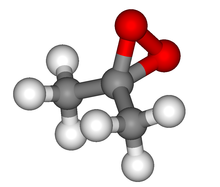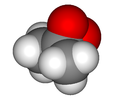
| |

| |
 Carbon, C Hydrogen, H Oxygen, O | |
| Names | |
|---|---|
| IUPAC name 3,3-Dimethyldioxirane | |
| Other names
DMDO Monoperoxyacetone, Murray's reagent | |
| Identifiers | |
| CAS Number | |
| 3D model (JSmol) | |
| ChemSpider | |
| PubChem CID | |
| UNII | |
| CompTox Dashboard (EPA) | |
InChI
| |
SMILES
| |
| Properties | |
| Chemical formula | C3H6O2 |
| Molar mass | 74.08 g/mol |
| Except where otherwise noted, data are given for materials in their standard state (at 25 °C , 100 kPa).
| |
Dimethyldioxirane (DMDO) is the organic compound with the formula (CH3)2CO2. It is the dioxirane derived from acetone and can be viewed as the monomer of acetone peroxide. It is a powerful selective oxidizing agent that finds some use in organic synthesis. It is known only in the form of a dilute solution, usually in acetone, and hence the properties of the pure material are largely unknown.
Synthesis
DMDO is not commercially available because of chemical instability. DMDO can be prepared as dilute solutions (~0.1 M) by treatment of acetone with potassium peroxymonosulfate KHSO
5, usually in the form of Oxone (2KHSO5·KHSO4·K2SO4).
The preparation of DMDO is rather inefficient (typical yields < 3%) and typically only yields a relatively dilute solution in acetone (only up to approximately 0.1 M). This is tolerable as preparation uses inexpensive substances: acetone, sodium bicarbonate, and oxone. Cold solutions (−10 to −20 °C) of DMDO are stable for days. Decomposition is accelerated by light and by heavy metals. The concentration of DMDO may be assayed immediately prior to its use.
Methyl(trifluoromethyl)dioxirane (H
3C)(F
3C)CO
2 can be similarly prepared from methyl trifluoromethyl ketone. It is a stronger oxidant than DMDO.
Uses
DMDO is most commonly used for the oxidation of alkenes to epoxides. One advantage of using DMDO is that the only byproduct of oxidation is acetone, a fairly innocuous and volatile compound. DMDO oxidations are particularly mild, sometimes allowing oxidations which might not otherwise be possible.
Despite its high reactivity, DMDO displays good selectivity for electron-rich olefins. DMDO will also oxidize several other functional groups. For example, DMDO will oxidize primary amines to nitro compounds and sulfides to sulfoxides. In some cases, DMDO will even oxidize unactivated C-H bonds:
DMDO can also be used to convert nitro compounds to carbonyl compounds (Nef reaction).
See also
References
- Murray, Robert W. (July 1989). "Chemistry of dioxiranes. 12. Dioxiranes". Chemical Reviews. 89 (5): 1187–1201. doi:10.1021/cr00095a013.
- ^ Crandall, J. K.; Curc, R; D'Accolti, L; Fusco, C (15 Oct 2005). "Dimethyldioxirane". E-EROS Encyclopedia of Reagents for Organic Synthesis. doi:10.1002/047084289X.rd329.pub2. ISBN 0471936235.
- Robert W. Murray and Megh Singh (1997). "Synthesis of Epoxides using Dimethyldioxirane]: trans-Stilbene Oxide". Organic Syntheses. 74: 91. doi:10.15227/orgsyn.074.0091.
- Cossar, Peter J.; Baker, Jennifer R.; Cain, Nicholas; McCluskey, Adam (April 2018). "In situ epoxide generation by dimethyldioxirane oxidation and the use of epichlorohydrin in the flow synthesis of a library of β-amino alcohols". Royal Society Open Science. 5 (4): 171190. doi:10.1098/rsos.171190. ISSN 2054-5703. PMC 5936892. PMID 29765627.
- Adam, Waldemar; Makosza, Mieczyslaw; Saha-Möller, Chantu R.; Zhao, Cong-Gui (1998). "A Mild and Efficient Nef Reaction for the Conversion of Nitro to Carbonyl Group by Dimethyldioxirane (DMD) Oxidation of Nitronate Anions". Synlett. 1998 (12): 1335–1336. doi:10.1055/s-1998-1947.

